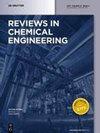Cyclone pressure drop reduction and its effect on gas–particle separation capability: principle, performance, and assessment
IF 4.9
3区 工程技术
Q1 ENGINEERING, CHEMICAL
引用次数: 1
Abstract
Abstract Cyclone separators have been widely used for gas–particle separation in chemical engineering. However, their enhancement in separation performances usually increases the pressure drop, which inevitably leads to an increase in operating energy consumption. One of the challenging issues is how to reduce the cyclone pressure drop while improving separation performances. To gain insight into the pathways and impacts of cyclone pressure drop reduction, this work reviews the state-of-the-art technical principles, performances and effects, focusing on the processes, mechanisms, and characteristics of pressure drop reduction by inlet/outlet variations, additional auxiliary devices, local cyclone dimension improvement, and global optimization based on intelligent algorithms. The cyclone performances are assessed using a proposed index that combines the Euler number and the square-root particle cut-off Stokes number. It is suggested that the pressure drop and separation capability usually have a dynamic compromise. Considering the comprehensive performances, the technology using helical roof inlet, cross cone, increasing cylindrical height with h/D = 4.3 (H/D = 6.35), and globally optimized design by Sun et al. (2017) are respectively considered to the others. Particularly, the last one is recommended to be more representative in practice. Finally, the key issues to be considered in further research were also prospected.旋风降压及其对气粒分离能力的影响:原理、性能及评价
摘要旋风分离器在化学工程中广泛应用于气粒分离。然而,它们分离性能的提高通常会增加压降,这不可避免地导致操作能耗的增加。如何在提高分离性能的同时降低旋流器压降是一个具有挑战性的问题。为了深入了解旋流器压降降低的途径和影响,本工作回顾了最先进的技术原理、性能和效果,重点介绍了通过入口/出口变化、附加辅助装置、局部旋流器尺寸改进、,以及基于智能算法的全局优化。使用结合欧拉数和平方根粒子截止斯托克斯数的拟议指数来评估气旋性能。这表明压降和分离能力通常具有动态折衷。考虑到综合性能,分别考虑了采用螺旋屋顶进气道、十字锥、h/D=4.3(h/D=6.35)增加圆柱高度的技术和Sun等人(2017)的全局优化设计。特别是,建议最后一种方法在实践中更具代表性。最后,对进一步研究中需要考虑的关键问题进行了展望。
本文章由计算机程序翻译,如有差异,请以英文原文为准。
求助全文
约1分钟内获得全文
求助全文
来源期刊

Reviews in Chemical Engineering
工程技术-工程:化工
CiteScore
12.30
自引率
0.00%
发文量
37
审稿时长
6 months
期刊介绍:
Reviews in Chemical Engineering publishes authoritative review articles on all aspects of the broad field of chemical engineering and applied chemistry. Its aim is to develop new insights and understanding and to promote interest and research activity in chemical engineering, as well as the application of new developments in these areas. The bimonthly journal publishes peer-reviewed articles by leading chemical engineers, applied scientists and mathematicians. The broad interest today in solutions through chemistry to some of the world’s most challenging problems ensures that Reviews in Chemical Engineering will play a significant role in the growth of the field as a whole.
 求助内容:
求助内容: 应助结果提醒方式:
应助结果提醒方式:


